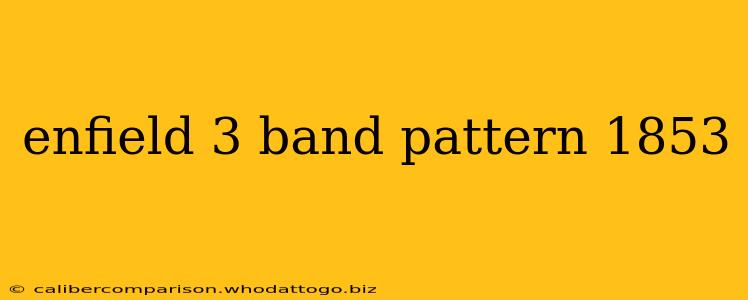The Enfield Pattern 1853 rifle, easily identifiable by its distinctive three-band system, holds a significant place in firearms history. This iconic weapon played a crucial role in mid-19th-century conflicts, and understanding its design and features offers a fascinating glimpse into the evolution of military weaponry. This article delves into the specifics of the Enfield 1853, exploring its construction, functionality, and historical context.
The Three-Band System: A Key Identifier
The "three-band" designation refers to the three bands encircling the rifle's barrel, used to secure the barrel to the stock. These bands, typically made of iron or steel, were a significant departure from earlier designs and contributed to the rifle's improved accuracy and robustness. This system provided superior barrel support compared to previous single-band or two-band configurations, minimizing barrel flex and vibrations during firing. The precise placement and design of these bands were crucial to the rifle's overall performance.
Beyond the Bands: Examining the Enfield 1853's Construction
The Enfield 1853 wasn't just defined by its bands. The rifle showcased several innovative features for its time:
- The Percussion Cap System: The Enfield 1853 was a percussion cap rifle, meaning ignition relied on a small copper cap containing a volatile explosive compound detonated by the hammer. This system provided a more reliable ignition compared to earlier flintlock mechanisms.
- The .577 Caliber Round: The rifle fired a relatively large .577 caliber round, delivering considerable stopping power at the time. The bullet's design and the rifle's rifling contributed to the weapon's effective range.
- The Rifle's Stock: Typically crafted from wood, the stock provided both structural support and a comfortable grip for the user. The wood type varied depending on availability and manufacturing location.
- The Bayonet: Most Enfield 1853 rifles were equipped with a socket bayonet, extending the weapon's reach and utility in close-quarters combat.
The Enfield 1853 in Historical Context
The Enfield 1853 saw extensive use in various conflicts, shaping the course of 19th-century warfare. Its widespread adoption by the British Army cemented its place in history. The rifle's impact extended beyond battlefields; it played a pivotal role in the development of mass-production techniques and advancements in firearms technology.
Variations and Manufacturing
It's important to note that the Enfield 1853 wasn't a uniform design. Variations existed across different manufacturing periods and locations. Minor differences in features like the band design, stock configuration, and even the specific type of metal used could be observed. These subtle variations make studying individual Enfield 1853 rifles a rewarding and detailed pursuit.
The Legacy of the Enfield 1853
The Enfield Pattern 1853 remains an object of fascination for historians, collectors, and firearms enthusiasts alike. Its simple yet effective design, coupled with its historical significance, ensures its enduring legacy. Understanding the intricacies of this rifle provides a valuable insight into the evolution of military technology and the weaponry that shaped the course of 19th-century warfare. The three-band pattern, though just one aspect of the rifle's design, serves as a powerful visual identifier of this pivotal piece of firearms history.

